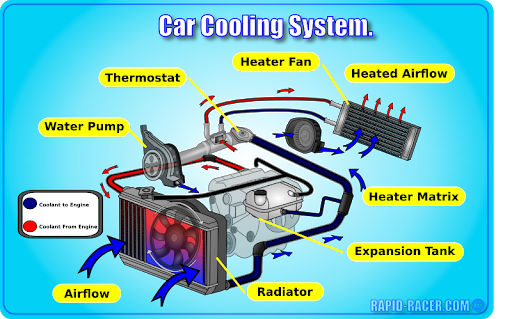Your car’s cooling system plays a crucial role in maintaining engine temperature and preventing overheating, especially during hot weather or extended driving. Regular maintenance of your cooling system can prevent engine damage, save money on repairs, and extend the life of your vehicle.
Follow these simple steps to keep your cooling system in top condition and avoid costly repairs down the road.
1️⃣ Check Coolant Levels Regularly
🔎 Why It’s Important:
✔ Coolant (or antifreeze) helps regulate your engine’s temperature, preventing it from overheating.
✔ Low coolant levels can cause the engine to overheat, leading to damage.
🛠 How to Check It:
✅ Park your car on a level surface and wait for the engine to cool.
✅ Open the radiator cap (only when the engine is cool) or check the coolant reservoir.
✅ The coolant should be between the “low” and “high” marks on the reservoir.
🚨 Low coolant levels can lead to overheating—fill it up with the appropriate coolant!
2️⃣ Inspect the Radiator for Leaks
🔎 Why It’s Important:
✔ The radiator carries coolant through the engine to absorb heat.
✔ Leaks in the radiator can cause coolant loss, resulting in overheating.
🛠 How to Inspect It:
✅ Visually inspect the radiator for signs of cracks, rust, or wet spots.
✅ Check for coolant puddles underneath the car.
✅ Inspect the radiator hoses for leaks or bulges.
🚨 If you notice leaks, replace the radiator or hose immediately to prevent engine damage!
3️⃣ Flush & Replace Coolant
🔎 Why It’s Important:
✔ Over time, coolant can break down and become contaminated.
✔ Old coolant may not perform well, leading to overheating or rust in the engine.
🛠 How to Flush It:
✅ Consult your owner’s manual for the recommended coolant replacement interval (typically every 30,000–50,000 miles).
✅ To flush the coolant, remove the radiator cap, open the drain valve, and let the old coolant drain out.
✅ Refill the system with fresh coolant, ensuring you use the correct mixture (usually a 50/50 mix of coolant and water).
🚨 Don’t mix different coolant types—they can cause damage to the engine!
4️⃣ Check the Thermostat for Functionality
🔎 Why It’s Important:
✔ The thermostat regulates the flow of coolant, ensuring the engine doesn’t overheat.
✔ A malfunctioning thermostat can cause the engine to run too hot or too cold, leading to inefficiency or overheating.
🛠 How to Check It:
✅ If the engine overheats or the temperature gauge doesn’t move, the thermostat might be stuck.
✅ You can test the thermostat by removing it and placing it in hot water to see if it opens up.
✅ If the thermostat doesn’t function properly, replace it with a new one.
🚨 A stuck thermostat can cause the engine to overheat—replace it immediately!
5️⃣ Inspect and Maintain the Water Pump
🔎 Why It’s Important:
✔ The water pump circulates coolant through the engine and radiator, ensuring proper cooling.
✔ A failing water pump can lead to coolant leaks or cause the engine to overheat.
🛠 How to Inspect It:
✅ Look for signs of leaks around the water pump or a grinding noise when the engine is running.
✅ Check the drive belt for wear and tear.
✅ If the water pump is faulty, replace it immediately to prevent engine damage.
🚨 Ignoring a bad water pump can lead to serious engine problems—inspect it regularly!
6️⃣ Monitor the Cooling Fan Operation
🔎 Why It’s Important:
✔ The cooling fan helps reduce engine temperature when the car is idling or moving slowly.
✔ A malfunctioning fan can cause the engine to overheat.
🛠 How to Check It:
✅ Start the car and let it idle while monitoring the cooling fan.
✅ The fan should turn on automatically when the engine reaches a certain temperature.
✅ If the fan doesn’t work, check the fuses, relays, and wiring. Replace any faulty components.
🚨 A non-working cooling fan can cause severe overheating—get it checked promptly!
7️⃣ Maintain the Radiator Cap & Pressure
🔎 Why It’s Important:
✔ The radiator cap maintains proper pressure in the cooling system, which prevents coolant from boiling over.
✔ A damaged or loose cap can lead to coolant loss or system failure.
🛠 How to Maintain It:
✅ Ensure the radiator cap is properly secured and free from cracks or damage.
✅ Inspect the rubber seal for signs of wear.
✅ Replace the cap if it’s damaged or doesn’t seal properly.
🚨 A faulty radiator cap can cause coolant to boil over—replace it when needed!
Need Cooling System Repairs? Visit Onsite Auto Services!
🚗 Worried about your car’s cooling system? At Onsite Auto Services, we provide coolant flushes, radiator repairs, thermostat checks, and more to ensure your car stays cool and runs efficiently.
📞 Call us today or schedule an appointment online for a cooling system inspection!
CoolingSystem #CarMaintenance #RadiatorCare #EngineCooling #CarOverheating #ThermostatReplacement #WaterPump #CoolantFlush #VehicleHealth #MechanicNearMe
“Prevent overheating! Learn how to check and maintain your car’s cooling system, from coolant levels to radiator care, to keep your engine running smoothly.”

